
The First Congregational Church and Parsonage is a historic church complex at 23 Pepperrell Road in the Kittery Point section of Kittery, Maine. Built in 1730 for a congregation first organized in 1653, the church is the oldest in Kittery, and one of the oldest in the state of Maine. It is accompanied by a parsonage house, built in 1729, and a small cemetery, established in 1733. The buildings were listed on the National Register of Historic Places in 1978; the cemetery was added to the listing in 1997.

The First Parish Congregational Church is a historic church at 116 Main Street in Yarmouth, Maine. The congregation was established in 1730, as the ninth church founded in what is now Maine. The current Italianate meeting house was constructed in 1867–68, and is an important surviving design of Portland architect George M. Harding. The building was added to the National Register of Historic Places in 1995. The present congregation is affiliated with the United Church of Christ.

Yarmouth is a town in Cumberland County, Maine, United States, twelve miles north of the state's largest city, Portland. When originally settled in 1636, as North Yarmouth, it was part of the Massachusetts Bay Colony, and remained part of its subsequent incarnations for 213 years. In 1849, twenty-nine years after Maine's admittance to the Union as the twenty-third state, it was incorporated as the Town of Yarmouth.
The historical buildings and structures of Yarmouth, Maine, represent a variety of building styles and usages, largely based on its past as home to almost sixty mills over a period of roughly 250 years. These mills include that of grain, lumber, pulp and cotton. Additionally, almost three hundred vessels were launched by Yarmouth's shipyards in the century between 1790 and 1890, and the homes of master shipwrights and ship captains can still be found throughout the town.
The history of Yarmouth, Maine, is closely tied to its position on the banks of the Royal River and its proximity to Casco Bay, an inlet of the Gulf of Maine, itself a gulf of the Atlantic Ocean.
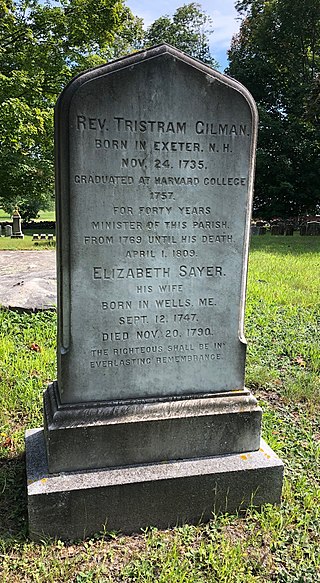
Tristram Gilman was an American Congregational minister who served as the fourth pastor of the "Old Ledge" meetinghouse in what was then North Yarmouth, Massachusetts, for forty years. Gilman Road, adjacent to where the church formerly stood, is now named for him.
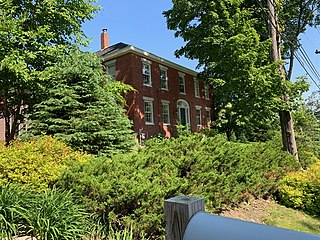
Pleasant Street is a historic street in Yarmouth, Maine, United States. It was formerly part of the Atlantic Highway, a precursor to U.S. Route 1. It connects to Lafayette Street, part of today's Maine State Route 88, at Pleasant Street’s southern and northern ends. It has existed since at least 1761, which is when a milestone was placed on the street, on the order of Benjamin Franklin, due to its being on the King's Highway, to denote its distance from Boston, Massachusetts. As part of his duties, Franklin conducted inspections of the roads that were used for delivering mail. One method of charging for mail service was by mileage, so Franklin invented an odometer to measure mileage more accurately. The King's Highway, as a result, morphed into the Post Road.

Old Baptist Cemetery is a historic cemetery in Yarmouth, Maine, United States. Dating to the late 17th century, it stands on Hillside Street, adjoining the North Yarmouth and Freeport Baptist Meetinghouse, a National Register of Historic Places property, on its southern side. It is the only burial site in the town attached to an extant church building.
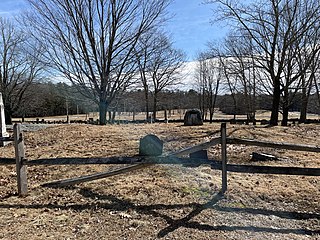
Ledge Cemetery, also known as the Cemetery under the Ledge, is a historic cemetery in Yarmouth, Maine, United States. Dating to 1770, it stands on Gilman Road, around 450 feet (140 m) southwest of the older and smaller Pioneer Cemetery. Some headstones bear dates earlier than 1770, for many burials—such as that of Revd. Nicholas Loring—were removed from the older cemetery

Ammi Ruhamah Cutter was an American Congregational minister who served as the first pastor of the "Old Ledge" meetinghouse in what was then North Yarmouth, Province of Massachusetts Bay.
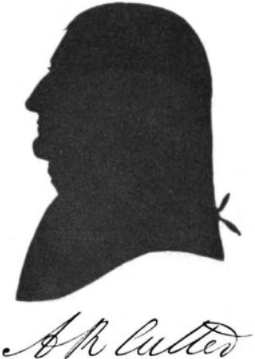
Ammi Ruhamah Cutter was an American physician. He served as a surgeon during the French and Indian War of 1754–1763, and was also the Physician General of the medical department of the Continental Army during the American Revolutionary War of 1775–1783.
Nicholas Loring was an American Congregational minister who served as the second pastor of the "Old Ledge" meetinghouse in what was then North Yarmouth, Province of Massachusetts Bay. He died while in the 28th year of his tenure.
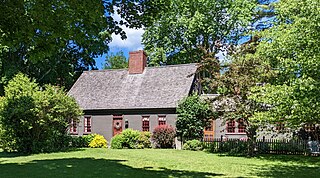
Ammi Ruhamah Mitchell was an 18th- and 19th-century American physician. He also served ten years in the Massachusetts Legislature.

The Gilman Manse is an historic home at 463 Lafayette Street in Yarmouth, Maine. Built in 1771, making it one of the oldest extant buildings in the town, it was originally the home of Tristram Gilman, the fourth minister of the now-demolished Meetinghouse under the Ledge, which stood around 900 feet (270 m) to the northeast between 1729 and 1836. It succeeded the Cutter House, at 60 Gilman Road, as the parsonage for the church.

The Cutter House is an historic home at 60 Gilman Road in Yarmouth, Maine, United States. Built in 1730, over a century before today's Yarmouth was incorporated, it is the oldest extant building in the town. It was built for Ammi Ruhamah Cutter, the first minister of the now-demolished Meetinghouse under the Ledge, which stood around 150 yards (140 m) to the west, in the same strip of land between Gilman Road and Lafayette Street, between 1729 and 1836. It stands almost directly across Gilman Road from the Pioneer Cemetery, which was established a year later. The home, the Pioneer Cemetery and the nearby Ledge Cemetery are all that remain of this early settlement.
Gilman Road is a prominent street in Yarmouth, Maine, United States. It runs for about 1.7 miles (2.7 km) from Lafayette Street in the northwest to the Ellis C. Snodgrass Memorial Bridge at White's Cove in the southeast. At the bridge, which connects the Yarmouth mainland to Cousins Island, the road becomes Cousins Road.

Drinkwater Point Road is a prominent street in Yarmouth, Maine, United States. One of the first streets laid out in what was then coastal North Yarmouth, Province of Massachusetts Bay, it runs for about 0.45 miles (0.72 km) from Gilman Road in the north to Seaborne Drive in the south. Drinkwater Point faces Cousins Island, to which it is connected by the Ellis C. Snodgrass Memorial Bridge, and overlooks inner Casco Bay.
Edward Brooks was an American Congregational minister who served as the third pastor of the "Old Ledge" meetinghouse in what was then North Yarmouth, Province of Massachusetts Bay.
Jacob Curry Mitchell was an American deacon who became prominent in what is now Yarmouth, Maine.
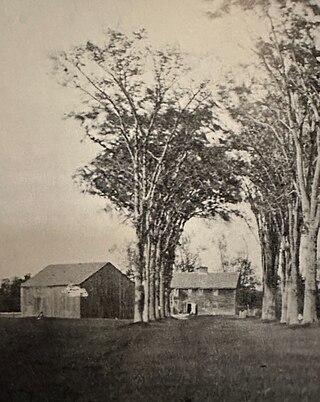
The Mitchell garrison was an important building in what was, at the time, North Yarmouth, Province of Massachusetts Bay. Built in 1728 at the rear of today's Holy Cross Cemetery, adjacent to Riverside Cemetery on a bluff around 50 feet (15 m) above the Royal River, it was used as a stockade during the Indian wars. Despite its later usage, the term "garrison" refers to its architectural style.














